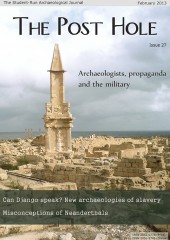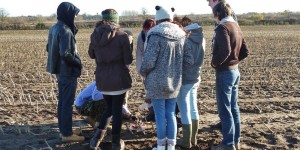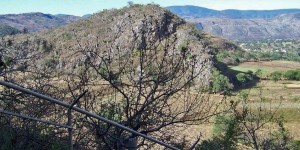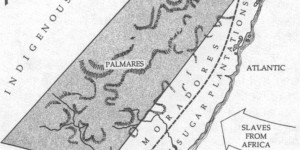As part of my Evolving Minds MSc Masters module at the University of York, I decided to have a look at key academic literature on Neanderthals from 1865 to the present day. In doing so, I detected patterns of change in opinion that were steered heavily by external factors, and by key research. The Piltdown hoax and Social Darwinism strongly mediated understanding for a long time prior to the 1950s. Racism has hopefully left the arena, but one problem remains: we are still an archaeology of comparison and exclusion; not with races, but with extinct hominins.
In addition, I noted that literature would be published along a certain line of ideas for a decade or so supporting the evidence of the last key research. Then, a key paper would change opinion followed by literature supporting the new avenue. Rather than enhancing our understanding of Neanderthals, this in fact seemed to be a limiting factor; especially considering that such key pieces of research could later prove to be erroneous.
The chronology of papers starts with British scientist C. Carter Blake (1865) who published a synthesis of the different views on the Feldhofer Neanderthal fossil, the first recognised Neanderthal specimen. The paper was published 9 years after the Feldhover discovery, and aside from some contemplation on whether the fossil was an ape or a human, the majority consensus was that the explanation was racial: that this was a primitive human ancestor with links to Australian aborigines (also deemed primitive in those times) (Blake 1865).
Social Darwinism abounds through the article with Celtic skulls deemed the most advanced, in line with the European race, while other races were deemed less evolved and at various primitive stages (Blake 1865). Cages of ‘Neanderthaloid apes’ were promised from Africa which is particularly disturbing, while geologist Prof. William King was reported to be especially concerned about whether the Feldhover Neanderthal was God-fearing (Blake 1865). It is obvious that the paper is very much a product of its time.
The next key Neanderthal paper was written by Boule and Anthony (1911), from which we see their perspective on a very primitive being discovered at La Chappelle aux Saints, from their analysis of endocasts. Boule and Anthony (1911) see evidence of a brutish being, noting that its brain may be the size of a modern human’s, but that it was more primitively arranged.
This brutish image continues with American Henry Fairfield Osbourne’s (1927) article, where he sees the Neanderthal as a genetically distant and incompetent being. This article is strongly swayed by Piltdown Man (the famous hoax), because Osbourne had long held the view that humans were an ancient being, ‘full-brained’ as far back as the Miocene period, referring to them as ‘Dawn Men’ (Osbourne 1927).
Therefore, he delighted in the Piltdown fossil, which showed what he thought to be a modern cranium (as it was!) from the Miocene (Osbourne 1927). Osbourne called for a dismissal of there being an evolutionary link between modern humans and apes completely. This he gave humanity a white European origin (stating that only the hardship of icy northern Europe could cause the evolution of the human mind); in his eyes, Neanderthals were violent animalistic creatures overthrown by superior Homo sapiens (Osbourne 1927).
However, the tide had changed by 1940, with no more mention of Piltdown Man due to the new discovery of ‘transitional’ Neanderthals or Homo sapiens (Galilee Man) in the Levant. The anthropologist, Franz Weidenreich (1940) sees an evolutionary link with a more human Neanderthal that evolved into modern Arabian peoples (though not Europeans, he hastily states). He does warn against ‘inveterate prejudice against Neanderthal man’, revealing that the academic image of the Neanderthal had shifted since Boule’s representation, following the discovery of possibly mosaic Levant fossils (Weidenreich 1940). However, it is clear that racist ideas still played a part in interpretations.
We see a difference in the early 1950s though, with Howell’s (1951) post-war article, where racial interpretations are avoided, and in fact, are replaced by objective, clinical science. Howell carefully examined Neanderthal fossils to deduce whether they evolved into Homo sapiens or were replaced; his research fuelled by the Levant specimens and the possible admixing that occurred. He warns against archaeologists ‘making sport’ with Neanderthal morphology to find abstract interpretations such as them using their teeth as tools (Howell 1951).
The subject of race may have started to be avoided, as in Howell (1951) due to self-consciousness in the wake of the Holocaust. Howell concluded that the early Swanscombe fossil craniums were more like Homo sapiens than later classic Neanderthals and suggests that Neanderthals evolved themselves into a cul-de-sac of extreme morphology (Howell 1951).
This detached functionalism continues in Jelinek’s (1969) seminal article, which looked with strict objective control at the European fossil base. His conclusions are interesting: no longer is the Neanderthal a separate species. Acknowledging the amount of skull features Neanderthals have in common with Homo sapiens, Jelinek (1969) creates a new classification for them: Homo sapien neanderthalensis. He also finds that their culture, like ours, is variable and that their dates cross over in Europe, so we now have co-existence (1969).
Looking back at the conclusions of same species status that came from this very clinical approach, some very recent findings still seem to agree with this (Green et al. 2010), which will be explained later. However, the theory of Homo sapiens evolving from Neanderthals in the Levant is still present in the article (Jelinek 1969).
The 1970s saw a change in views of Neanderthals, with the highly influential Neanderthal ‘Shanidar flower burial’ (Solecki, 1975), and Trinkhaus’ (1978) observations at Shanidar of care given to a greatly debilitated individual. Neanderthals now have a human spirit, and research a more human, less coldly clinical, edge to it. Bräuer (1981) finds a Neanderthal hybrid at Hanofersand (now known to be Holocene in date). Neanderthals have now become close cousins and fellow humans within research.
This recent theme appears to be somewhat changing with the adoption of mitochondrial DNA analyses in archaeology. Cann et al. (1987) seem to have found a mitochondrial Eve in Africa, related closely to modern humans, who lived around 200,000 years ago (Cann et al. 1987). This results in a newly perceived gulf between us and the Neanderthals, if our genetic origin was in Africa. We are seen as something different, possibly better, that outcompeted the Neanderthals on our arrival in Europe and West Asia. There is now a new research focus: what was inadequate about the Neanderthals and what was superior about us?
Wynn and Coolidge (2004) believe Neanderthals cannot think properly, with an inflexible mind that cannot make connections between animals and tools, or people and plants; and who cannot invent new ways to knapp flint. Mithen (2005) agrees and states that they could not even speak, and presumably lolloped around mindlessly chasing mammoths on tundras (Richards and Trinkhaus 2003) with one kind of axe and thrusting spear (Wynn and Coolidge 2004) for 300,000 years, unable to think of anything else to do, until we arrived with our words, our projectiles, our flexible ideas, our necklaces and the unique all-empowering concept that you can catch fish and eat plants. Can you tell that I do not agree? The key research question had become ‘just what was wrong with those human-shaped failures?’
Then we have a genome. The Max Planck Institute began publishing results of its reconstruction of the Neanderthal genetic code in 2007, from an exciting recently found site called El Sidron in Spain (Lalueza-Fox et al. 2012). Here, Neanderthal bones had been encased in cave sediments, untouched and uncontaminated since the time of their deposition (Lalueza-Fox et al. 2012).
We have the FOXP2 gene (Krause et al. 2007) which means they could possibly talk (although it must be remembered that genes work as a collective with other genes, in complex ways; not usually in isolation). Also discovered was that they had varied pigmentation (Lalueza-Fox et al. 2007), which could mean they had races like us. Then the most ground-breaking paper of all: Neanderthals and Homo sapiens had interbred (Green et al. 2010). People outside of Africa are shown to carry a small percentage of Neanderthal DNA, which would mean that we are not a different species after all, as different species cannot produce fertile young together (Mayr 2002, 183). Producing fertile young together is the definition of a species.
The paper by Green et al. (2010) on shared genetics has been followed by a wave of published research that demonstrates cognitive equality with Neanderthals, not difference, that they decorated themselves with painted shells (Zilhao et al. 2010), wore ornamental feathers selectively taken from raptors (Morin and Laroulandie 2012), painted seals (MacErlean 2012) on stalactites in Spain (although this researched has not yet been peer- reviewed) and even sailed to Crete on Neanderthal-made boats (Ferentinos et al. 2012).
So who and what were Neanderthals? In all these shifts and sways of academic opinion, and moves in and out of different trends (some found to be erroneous), what is correct? I have to say, sometimes the paper that says the least, in terms of speculation and trend-following, says the most.
Jelinek’s (1969) paper does stand out, his detached forensic analysis gives us more, and we see a young Richard Klein (a very big name now in Palaeoanthropology and author of the excellent 2009 Human Career) request in a reply that the same objective analysis of the whole Neanderthal fossil record be performed. I would agree: we should take away all stances on how human they were or not and just look at what we have archaeologically, including genetics and material culture, and take it from there.
However, this shifting and swaying process that we have may also be leading us somewhere, perhaps to a better understanding. It seems, however, that trends have too powerful a place in who and what gets published. Is that coming from publishers or from academics? Also, the old cultural stance we as humans have on other species, of us being the most advanced creature on the planet, forever judging other species as we used to judge other races, judging even past humans as inferior, harks back to the initial Social Darwinism that we saw in 1865.
Palaeo-archaeology is still a discussion of the measure of exclusion and inclusion, rather than who hominins were, those successful humans who walked this earth far longer than we have, in their own right as men, women, or children.
Does this apply to other archaeological fields? Are they steered by shifts and trends, are they focused on inclusion and exclusion of past people as equals to ourselves? Can they be misdirected for a decade by too powerful a sway held by a faulty key paper? This discussion isn’t aimed at devaluing academic publishing, nothing should: good, well-researched papers are essential, but maybe a little objectivity and awareness of why trends are occurring may be the practise of a good archaeologist.
In the end, it is the physical archaeology itself that is the anchor, while ships of ideology float randomly above it in ever changing directions. In addition, a good archaeologist must be mindful of stances of superiority, and of how valid, useful and ethical such stances might be.
Bibliography
- Blake, C.C. (1865) ‘On the alleged peculiar characters and assumed antiquity of the Human cranium from the Neanderthal’, Journal of the Anthropological Society of London. 2, cxxxix-clvii
- Boule, M. and Anthony, R. (1911) ‘L'encéphale de l'homme fossile de la Chapelle-aux-Saints’. L’anthropologie, 129-196
- Bräuer, G. (1981) ‘New evidence on the transitional period between Neanderthal and modern man’. Journal of Human Evolution 10 (6), 469-474
- Cann, R., Stoneking, M. and Wilson, A.C. (1987). ‘Mitochondrial DNA and Human Evolution’. Nature. 325. 31-36
- Ferentinos, G., Gkioni, M., Geraga, M., Papatheodorou, G. (2012) ‘Early seafaring activity in the southern Ionian Islands, Mediterranean Sea’. Journal of Archaeological Science 30, 1–10
- Green, R. E., Krause. J., Briggs, A. W., Maricic, T., Stenzel, U., Kircher, M., Patterson, N., Li, H., Zhau, W., Fritz, M. H-Y., Hansen, N. F., Durand, E. Y., Malaspinas, A-S., Jensen, J. D., Marques-Bonet, T., Alkan, C., Prufer, K., Meyer, M., Burbano, H. A., Good, J. M., Schultz, R., Axium-Petri, A., Butthof, A., Hober, B., Hoffner, B., Siegemund, M., Weihmann, A., Nusbaum, C., Lander, E. S., Russ, C., Novod, N., Affourtit, J., Egholm, M., Verna, C., Rudan, P., Brajkovic, D., Kucan, Z., Gusic, I., Doronichev, V. B., Golovanova, L. V., Lalueza-Fox, C., de la Rasilla, M., Fortea, J., Rosas, A., Schmitz, R. W., Johnson, P. L. F., Eichler, E. E., Falush, D., Birney, E., Mullikin, J. C., Slatkin, M., Nielsen, R., Kelso, J., Lachmann, M., Reich, D., Paabo, S. (2010) ‘A draft sequence of the Neandertal genome’. Science 328, 710–722
- Howell, F.C. (1951) ‘The place of Neanderthal Man in human evolution’. American Journal of Physical Anthropology. 9 (4). 379-416
- Jelinek, J. (1969) ‘Neanderthal Man and Homo sapiens in Central and Eastern Europe’. Current Anthropology 10 (5), 475-503
- Klein, R. (2009) The human career: human biological and cultural origins. Chicago: University of Chicago Press
- Krause, J., Lalueza-Fox, C., Orlando, L., Enard, W., Green, R.E., Burbano, H.A., Hublin, J-J., Hänni, C., Fortea, J., de la Rasilla, M., Bertranpetit, J., Rosas, A., Pääbo, S. (2007) ‘The derived FoxP2 variant of modern humans was shared with Neanderthals’. Current Biology 17 (21). 1908-1912
- Lalueza-Fox, C., Römpler, H., Caramelli, D., Stäubert, C., Catalano, G., Hughes, D., Rohland, N., Pilli, E., Longo, L., Condemi, S., de la Rasilla, M., Fortea, J., Rosas, A., Stoneking, M., Schöneberg, T., Bertranpetit, J., Hofreiter, M. (2007) ‘A Melanocortin 1 Receptor Allele Suggests Varying Pigmentation Among Neanderthals’. Science. 318 (5855). 1453-1455
- Lalueza-Fox, C., Rosas, A. and de la Rasilla, M. (2012) ‘Palaeogenetic research at the El Sidron Neanderthal site’. Annals of Anatomy. 194 (1). 133–137
- MacErlean, K. (2012) ‘First Neanderthal paintings discovered in Spain’. New Scientist. Available at http://www.newscientist.com/article/dn21458-first-neanderthal-cave-paint... [Accessed 25th February 2012]
- Mayr, E. (2002) What evolution is. London: Orion Books Ltd.
- Mithen, S. (2005) The Singing Neanderthals: the origin of music, language, mind and body. London: Weidenfeld and Nicolson
- Morin, E. and Laroulandie, V. (2012) ‘Presumed symbolic use of diurnal raptors by Neanderthals’, PloSONE [online] Available at: http://www.plosone.org/article/info%3Adoi%2F10.1371%2Fjournal.pone.0032856 [accessed 16th April 2012]
- Osbourne, H. F. (1927) ‘Recent discoveries relating to the origin and antiquity of man’. Proceedings of the American Philosophical Society. 66. 378-389
- Richards, M. P. and Trinkhaus, E. (2009) ‘Isotopic evidence for the diets of European Neanderthals and early modern humans’. PNAS. 106 (38). 10634–10639
- Solecki, R. S. (1975) ‘Shanidar IV: a Neanderthal flower burial in northern Iraq’. Science. 190 (4217). 880-881
- Stringer, C. and Gamble, C. (1994) In search of the Neanderthals: solving the puzzle of human origins. London: Thames and Hudson
- Trinkhaus, E. (1978) ‘Hard times among the Neanderthals’. Natural History. 87. 140-145
- Weidenreich, F. (1940) ‘Some problems dealing with Ancient Man’. American Anthropologist. 42 (3). 375-383
- Wynn, T. and Coolidge, F. L. (2004) ‘The expert Neanderthal mind’. Journal of Human Evolution. 46. 467–487
- Zilhao, J., Angelucci, D.E., Badal-Garcia, E., d’Errico, F., Daniel, F., Dayet, L., Douka, K., Higham, T.F.G., Martinez-Sanchez, M.J., Montes-Bernandez, R., Murcia-Mascaros, S., Perez-Sirvent, C., Roldan-Garcia, C., Vanhaeren, M., Villaverde, V., Wood, R., Zapata, J. (2010) ‘Symbolic use of marine shells and mineral pigments by Iberian Neanderthals’, PNAS. Available at: http://www.pnas.org/content/early/2010/01/06/0914088107.full.pdf+html [Accessed 1st February 2012]








